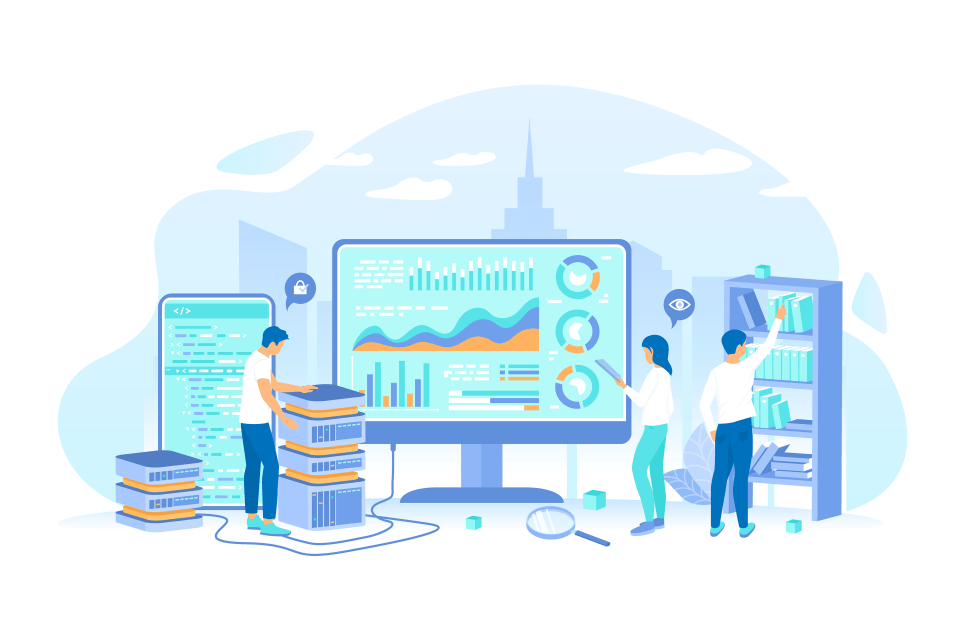Digital Marketing SEO Series: So…How Does Google Rank All Those Websites?
In the first post of our digital marketing SEO series, we discussed how Google processes search terms and how that changed with Google’s Fred update. Now, let’s talk a bit about how Google analyzes and ranks all of the estimated 1 billion websites that exist on the Internet. Though it’s always being tweaked, Google essentially uses about 200 different on-page and off-page “signals” to determine organic search ranking. Signals are things like the age of your domain, whether or not your keyword appears in the top-level domain, your site’s H1 and H2 tags, page load speed, etc. Some signals are completely proven and understood. SEO nerds have more-or-less determined that the Holy Trinity of ranking signals at the moment are:
- Backlinks: Though one of the oldest ranking factors, backlinking is hugely important, and it still counts as a “vote” for a website. After all, if a site’s content is good enough to create a link to it, it probably has some value, right? If hundreds or even thousands of people link to it, that cumulative “vote” commands a lot of “authority,” according to the Google algorithms. SEO strategy should always include a plan to boost the number of backlinks, which is a topic we will be covering in an upcoming blog post.
- Content: We talk about the importance of content so often that’s its practically become cliché. But the importance of it can’t be overstated, and it’s only going to continue to grow in importance. For content to be considered really great by Google, it needs to have the following characteristics:
- Freshness – It needs to be fresh. A post per week is good. A post per day is great.
- Originality – If you’re copying and pasting content from other online sources, you’re going to be penalized. Period. Google sees everything, because nearly all web content eventually gets seen and indexed by its crawlers.
- Written for Your Users – This is huge. RankBrain knows when content is being written to achieve a specific ranking result, and it penalizes it. The best way to approach your content is to identify issues that your customers have, then write content to address those issues. If you help your customers to solve problems and be successful, you too will become more successful with Google.
- Engaging – You need your visitors to take off their shoes and sit a spell, so to speak. If they are engaged with your content, their “dwell time” increases, which Google uses as a ranking signal.
- More Valuable Than Your Competition – You need to say what hasn’t been said, or at least explain it in a way that is more understandable. If the content is useful, people will inevitably want to share it, which Google recognizes and uses as a huge ranking signal for your site.
- Credible – It’s okay to use citation, reviews, links and testimonials in your content – just be sure you’re giving credit for it and not… ahem… “borrowing” it without mentioning the source. That kind of cross-linking, especially when the sources are trusted, spills some trust back onto your own site.
- Freshness – It needs to be fresh. A post per week is good. A post per day is great.
- RankBrain:Every day about 15% of all search queries contain words, phrases, or combinations of words that Google has never seen before. One of RankBrain’s primary jobs is to help make sense of those requests. An example I like to use is: “how to wash your car without soap.” Normally, Google would omit the word “without” and simply serve you results about what kind of soap to use to wash your car. There are, after all, many ways to wash your car without using soap. That may be weird, but Google respects our weirdness. With RankBrain, the word “without” suddenly has tremendous meaning. The algorithm understands what you’re actually trying to find, and will deliver organic search results about how to wash your car (without) soap:
An interesting thing about RankBrain is that there’s no way to optimize for it. According to Gary Illyes from Google, the best thing you can do to optimize for RankBrain is to simply write your content using natural language. If you’re unsure about whether or not your content is being written naturally enough, simply try reading it out loud. If it’s anything other than natural, hearing it spoken out loud is going to sound quite strange.
The important thing to remember is that RankBrain, links, and content are not separate pieces of a pie – they are integral parts of the same pie. You’re no longer writing for some specific component of Google – you’re writing for the end user.
Jackson Pollock??
Of course you must be wondering what Jackson Pollock, the creator of the Abstract Expressionism painting movement has to do with RankBrain. However, in an effort to explain the importance that Google places on interpreting content holistically, and on contextual relationships and semantic indexing, this example will serve well. Bear with me.
When you look at certain Jackson Pollock paintings up close, you’ll find that there’s something very unique about them. If you zoom into a tiny section of the overall painting, then enlarge that tiny section, the small section looks remarkably similar to the original painting! You can pull your sample from anywhere on the canvas, blow it up and VOILA! A new painting! It took the art world an astonishingly long time to figure it out, and it’s still being discussed. It was revolutionary.
I don’t know if anybody at Google has studied the paintings of Jackson Pollock, but the way that the Google algorithms view websites certainly suggests that it’s possible.
RankBrain looks at every single element on a web page, including links, images, navigation, content, inbound links, etc. and “paints a picture” of what that page is about. In theory, you should be able to look at any single element on a particular page, and be able to deduce what that page is about, just like the Jackson Pollock painting!
Working our way outwards, the same logic then extends to all of the individual pages contained within the framework of the larger website. Ideally, you should be able to land on any page of the website and be able to deduce what website you’re on. The smaller extracted piece is similar enough to the painting in its entirety that it can be used to identify the larger painting – even if viewed independently from the whole. That’s similar to what Google algorithms are looking to do – to identify the content and purpose of your web pages based on their elements.
It’s exactly that kind of logical interconnectedness of related elements and pages that RankBrain sees as a well-designed site. It then becomes possible to match organic search results with content that deeply satisfies the searcher’s intent.
How Does Advertising and Affiliate Marketing Fit Into The Equation?
Let’s not forget that at the end of the day, Google is a business. It’s a very specific and unique business model. Nobody knows for certain, but it’s estimated that Google brings in around $20 Billion in revenue from its AdWords platform. A significant part of that revenue is comprised of AdSense, which is completely dependent upon the ability to accurately position ads. In order to place the ads accurately, Google needs to first understand the site’s content. The ability to position ads accurately is dependent upon sites being predictable, which is critical to Google’s business model.
Some SEOs are convinced that the Fred update has to do with penalizing websites that have a lot of affiliate advertising, while simultaneously being thin on actual quality content. That makes a lot of sense when you consider that Google is simultaneously trying to deliver content to two primary groups of people: information seekers and consumers. The affiliate marketing muddies the waters when the Google algorithms try to index a website, because the affiliate marketing may or may not have anything to do with the content on the site.
More Ways Relational Content Plays a Role
Contextual relationships can pertain to much more than just semantically-related words. Absolutely everything on a web page can be analyzed and defined contextually. Google’s algorithms know how to accurately document and index a page based on how it’s built and what it does or does not contain.

For example, Google knows if you have an actual logo on the site, because it knows where a logo image file would normally live on the page, and about what size it should be. If you don’t have a graphic logo (versus just a text-based name) then Google penalizes your site for being less than professional. Google figures (correctly) that a trustworthy, professional site would go the extra mile and have an actual graphics-based logo! It’s completely logical and reasonable and affects organic search rankings immensely.
What Did We Learn?
Write Like a Human, Not Like a Machine
At this point, focusing on keywords is just going to get you into trouble. Even if done accidentally, keyword stuffing is a huge red flag to the Google algorithms and can drop your organic search ranking.
Keyword research these days is about understanding the space in which you’d like to rank. Tune your brain into the keyword lexicon that suits your needs and get a feel for which keywords you’d like to be ranking for – then put away the list and, if possible, don’t overtly think about it. You can’t outthink Google. Don’t even try.
Think Like Your Customers
Our clients’ sites that appear to have weathered the Fred update the best were those that had a LOT of useful content that never once mentioned the company name, or tried to deliver any kind of sales message. They took a “soft sell” approach, rather than a “hard sell.” Their blog posts spoke directly to their customer base, using language that was natural, and their SEO was already Google-friendly.

Intention is Everything
In the agency business, we are constantly evolving our approach to web design. We know all-too-well how design and relevancy affect usability. It gives us an advantage when designing for our clients because we’re thinking about these issues in the initial design stage. The one hard and fast rule is that form always follows function. After all, we want to lower bounce rate, boost dwell time and make relevant content easy to find, so that it gets shared, thus boosting organic search rank.
SEO should never be an afterthought. It’s not something you want to revisit after a site is launched. Think about your intention with the site. What do you want the site to do? Before ever building it, figure out the intent, and always follow SEO best practices as you build. You can find useful tips from Google here.
Following a solid plan, as well as best practices will ensure that SEO value is “baked in.” That will ultimately improve organic search rankings, resulting in a much more successful web presence, regardless of intent.
